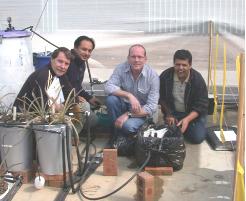Joint efforts on bubble visualisation for oxygation
Published on 20 August, 2009
With Australian farmers being put under tremendous pressure to improve water use efficiency and with recognition of the need to minimise negative environmental impacts of irrigation, CQUniversity researchers are developing an innovative method known as oxygation to irrigate responsibly...
Oxygation, which involves aerating irrigation water for drip and sub-surface drip irrigation, significantly improves crop water use efficiency and minimises the negative environmental impact of irrigation.
LINK here for a VIDEO interview about our plant sciences research
LINK here for a VIDEO interview about the oxygation project

Multidisciplinary team members ... Dr Surya Bhattarai (first from right), David Wassink (ANSTO Sydney), postdoctoral fellow Dr Pramod Shrestha and Prof David Midmore (Left) measuring the bubbles in the visualisation section in a pineapple oxygation trial. Oxygation can optimise the use of existing and new drip and subsurface drip irrigation systems by using air injection methods such as the Mazzei air injector, Seair and Oxycrop, which incorporate bubbles of heterogenous sizes in the irrigation water stream.
With the efficiency of oxygation largely depending on bubble behaviors in the irrigation water stream, increasing the abundance of micro-bubbles and maintaining the uniformity of bubble distribution along the length of irrigation lines becomes essential.
CQUniversity's Centre for Plant and Water Sciences (CPWS) is a pioneer in oxygation research. Researchers at CPWS are continuously working at understanding and improving aeration uniformity of the aerated water stream during oxygation.
In a joint collaborative project between CQUniversity and the Australian Nuclear Science and Technology Organization (ANSTO), researchers are developing a monitoring system that is based on visualisation and portable units suitable for field application.
Because of the wide variation between bubble populations, different bubble measurement systems are required depending upon the application.
David WASSINK of ANSTO visited CQUniversity Rockhampton this month (July 6-10) and worked with CPWS researchers Professor David Midmore, Dr Surya Bhattarai, Pramod Shrestha and Dr Ron Balsys from School of Computing Sciences for the prototype development and pilot testing of a bubble visualisation instrument for field applications.
The team developed a basic prototype and pilot testing is underway at CPWS.
The product will be fine-tuned and made ready by November.
This project is partly supported by a CQUniversity Merit Grant and AINSE (Australian Institute of Nuclear Science and Engineering) funding.

